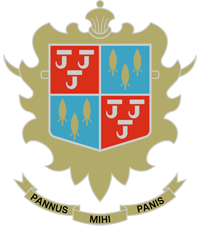Planning Committee
Planning Committee
To view the agenda and reports for this meeting, please click on the following link: https://www.kendaltowncouncil.gov.uk/wp-content/uploads/2013/12/08-04-24-Planning-Committee-Agenda-Pack.pdf
Kendal Town Council have produced two books ‘The Kendal Pattern Book’ (£4) and ‘From Knights to Town Council’ (£6). Both can be purchased from our office during opening hours.
Kendal was first put on the map officially with the arrival of the Romans in the first century AD. Considering the place to be of sufficient importance, they constructed a fort here (the site is at Watercrook on a bend of the River Kent, south of the modern settlement).
However the Romans were not the area’s first settlers – this honour fell to a tribe known as the Brigantes. A Roman fort required a lot of upkeep and its soldiers needed goods that they couldn’t necessarily provide for themselves. It was not long, therefore, before trading started between the two communities. Despite their initial misgivings about the new arrivals, the Brigantes found themselves involved in an activity that Kendal is still strongly associated with today, i.e. trade.
The Romans left in approximately the fourth century AD and were succeeded as “off-comers” some six centuries later by the Normans (the town was recorded in the Doomsday Book). At the time of the Norman Conquest there was already a motte and bailey castle on Castle Howe, to the west of the town centre. The castle now known as Kendal Castle was built on Castle Hill probably some time after 1183 although the actual date is uncertain. During this time there were also developments in the town’s religious and commercial life, with the Norman feudal system playing a large part in the structuring of the town’s politics and society.
However it was not until the granting of the Market Charter of 1189 that Kendal really began to make its mark. Richard I, desperate for money to fund his Crusades overseas, allowed the then Baron of Kendal, Gilbert Fitz-Renfried, to acquire a licence for a Saturday Market.
The money the King collected from this fee was channelled into Richard’s Crusades, whilst the Baron profited by levying other charges on the traders. The granting of the Charter heralded the arrival of ‘Market Kendal’, and the start of the town as we know it today. The earliest Charter still known to exist is that of Robert de Brus (see below) but the Saturday market created by the 1189 Charter still remains.
The thirteenth century was a time of increased expansion in the market and trading towns of England, and Kendal developed accordingly. The church came to hold great interest in market matters, and several ‘fairs’ were held to coincide with religious festivities. Sunday trading, as long as religious observances were dutifully upheld, was not considered a problem.
The earliest document in existence, relating to Kendal, is a Charter issued between 1246 and 1260 by the then Baron of Kendal, Peter de Brus. This confirmed the rights of burgesses, granted by his uncle Willian de Lancastre in an earlier Charter, of common pasture, to collect firewood from certain forests, to erect buildings and, most importantly, setting out agreements with fullers and dyers. This showed that the wool industry, which was later to become such an important aspect of Kendal’s economy, was active even at this early stage.
A significant event for the town in the16th century was the birth of Katherine Parr, famous as the wife who survived Henry VIII. The Parr family certainly owned the Castle at the time she was born, but whether she was born there or not is in dispute. However, many street names in the town bear tribute to the belief that she was a daughter of Kendal and the Town Council owns her prayer book which is in the private Mayors Parlour.
A second Royal Charter followed in 1636 when King Charles I gave Kendal the right to a Mayor (a privilege still enjoyed today) and a Sword of State. Kendal is one of only forty-seven towns to have been awarded such a sword. Even today the sword is carried in front of the Mayor and mace-bearers on civic occasions and is placed on the altar of the Parish Church on Mayor’s Sunday to represent the sovereign receiving authority from God.
The 16th to 18th centuries saw little major outside activity, apart from the Plague of 1597/98, which decimated the population, the Civil War and the Jacobite Risings of 1715 and 1745. The Civil War saw one of the more bizarre incidents in Kendal’s history when a soldier (Robert Philipson, known as ‘Robin the Devil’) rode his horse into the Parish Church in pursuit of his enemy, Colonel Briggs. The angry congregation drove him away, knocking his helmet off. The helmet, and a sword, hangs in the Church to commemorate the incident. The main memory of the events of 1745 is that Bonny Prince Charlie slept in a house in Stricklandgate on his way back to Scotland after his defeat at Derby (the same bed was slept in by his pursuer, the Duke of Cumberland, on the following night!).
The Town’s coat-of-arms, which first saw the light of day on a Speed map printed in 1610, reflects these historical influences. It has a gold background depicting a cowhide whilst the teasel (a prickly plant which dries like a sharp hairbrush) and bale hooks found in each of the sections of the shield represent the wool trade. The motto, pannus mihi panis, is often interpreted as ‘wool is my bread’ which would underline the importance of the industry which, for centuries, supported the people of this busy town.
The Kendal Pattern Book of 1769 was discovered during the disposal of salvage in the second World War by a Mr Jimmy Rigg. It subsequently came into the possession of local historian Jack O’Connor, who recognised it as an interesting and valuable link with the woollen trade of Kendal, which was established in the town in the 14th century by John Kemp, a Flemish weaver, acting under a “Letter of Protection” granted to him by Edward III in 1331. The book excited much interest and is now regarded as one of Kendal’s many treasures. An exhibition was held at Kendal Library in the summer of 2010. It took two years’ hard work by members of the Lancashire and Lakes Guild of Weavers, Spinners and Dyers, in collaboration with Kendal Town Council and Kendal Civic Society.
The wool business really began to flourish in the 14th century. The town’s position as a natural geographical centre for the Westmorland wool industry, together with a growing monastic wool trade, helped to transform local prospects at every level of life. As the industry grew, so did the town’s size and prosperity and it was not until the Industrial Revolution that the trade finally moved out to the mills in Yorkshire and Lancashire. Even today, on taking a walk around the town, you will still notice vestiges of the industry in the towns various signs and street names (e.g. Tenterfell. The tenter was the frame on which wool was stretched and dried, held by hooks, hence the phrase “on tenterhooks” meaning under tension.).
The Kendal Pals website was set up in remembrance of the Kendal Pals who served with the VIII (Service) Battalion, Border Regiment and those who lost their lives in the Great War 1914-1918. For more information, please click here and to read an extract from the 8th Battalion Border Regiment War Diaries, click here.
In the late seventeenth and into the eighteenth century, several Quaker and Methodist families became important in the town’s economy, find out more at Kendal’s Quaker Tapestry. In the nineteenth century, the people of Kendal began to move away from their tenant status and their desire for a greater autonomy grew.
This corresponded with a general increase in political awareness and there were a number of incidents on the streets of Kendal at Election time, particularly in 1818. Better markets in other places meant that more dealing was done out of town (shades of today’s “out of town Shopping Centres”) and, in the gap created, new industries evolved, supported by credit from the town’s banks. During this time, and into the twentieth century, the town added to its reputation by playing host to a number of religious, artistic and political figures. Amongst those visiting were Charles Wesley, the Quaker George Fox and, much later, Oswald Mosley.
Kendal’s more recent history has seen the rise, and fall, of industry, notably in snuff manufacture and shoe making. K Shoes, founded by the Somervell family in the 19th century, were one of the town’s main employers but, as with so many others, the company was taken over and the main manufacturing base has moved elsewhere. The K-Shoes Heritage Exhibition is currently in storage awaiting relocation following the recent closure and redevelopment of K-Village.

Find out more

Information
about Kendal’s
allotments

Learn about
The Mayor
of Kendal
To view the agenda and reports for this meeting, please click on the following link: https://www.kendaltowncouncil.gov.uk/wp-content/uploads/2013/12/08-04-24-Planning-Committee-Agenda-Pack.pdf
To view the agenda and reports for this meeting, please click on the following link: https://www.kendaltowncouncil.gov.uk/wp-content/uploads/2013/12/08-04-24-Full-Council-Agenda-Pack.pdf
To view the agenda and reports for the meeting, please click on the following link: https://www.kendaltowncouncil.gov.uk/wp-content/uploads/2013/12/15-04-24-Culture-and-Communities-Committee-Agenda-Pack.pdf
To view the agenda and reports for this meeting, please click on the following link: 22-04-24 V2 Planning Committee Agenda Pack
To view the agenda and reports for the meeting, please click on the following link: https://www.kendaltowncouncil.gov.uk/wp-content/uploads/2013/12/22-04-24-Audit-Committee-Agenda-Pack.pdf
